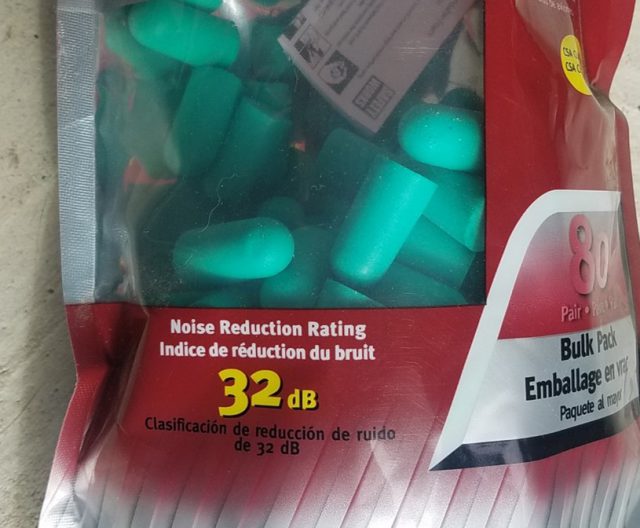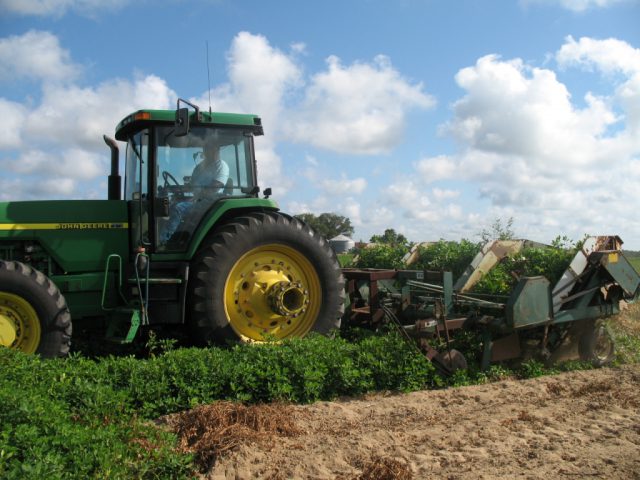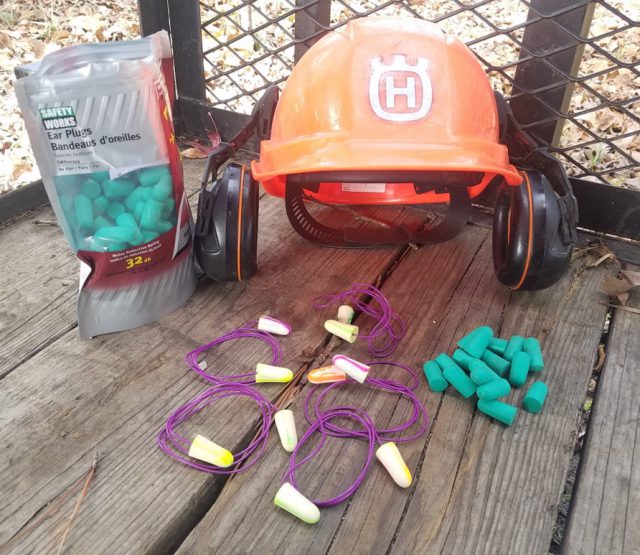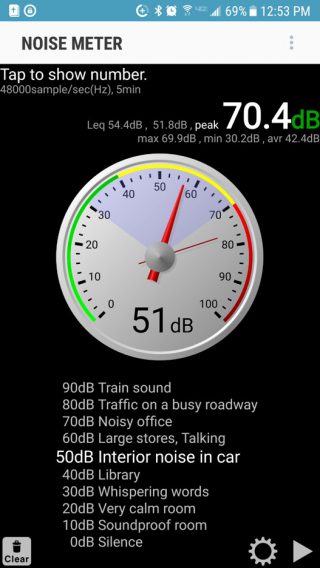I wear hearing aids, so that makes the subject of hearing loss near and dear to my heart! My hearing loss is due primarily to long term exposure to noisy equipment. Let’s face it, farming is a noisy occupation! The damage to hearing from exposure to loud noise is often undetectable – until it’s too late. Most of us just don’t see the need to wear those annoying hearing protective devices – until it’s too late.
Did you know that hearing loss cannot be reversed? Once it’s gone, it’s gone. Hearing aids are a marvel of science, and I for one am extremely thankful for them. Hearing aids, however, can only enhance the hearing capabilities you have left, and they are expensive. That is why it is so important to preserve and protect your hearing every day!
Below are some facts about hearing and the noise levels of farm equipment. I hope this information will help you make hearing protection a daily habit on the farm, at home, or in whatever work you do.
How loud is too loud?
Damaging noise levels are generated by many kinds of agricultural equipment, such as grain dryers, tractors, combines, livestock, generators, chainsaws, firearms, leaf blowers, air compressors, power tools, and aircraft. If you can’t hear someone talking from three feet away, or if you have to raise your voice to be heard, your surroundings are too loud. Ear pain, ringing in the ears, or muffled hearing after exposure to loud sounds also indicate damaging noise levels.
Sound is measured in “decibels” or “dB,” and, according to the National Institute for Occupational Safety and Health, noise measured over 85 dB is considered damaging to human hearing over extended periods of time. “Noise induced hearing loss can be caused by a one-time exposure to an intense “impulse” sound, such as an explosion, or by continuous exposure to loud sounds over an extended period of time, such as noise generated in a woodworking shop.”(Noise-Induced Hearing Loss, National Institute on Deafness and Other Communication Disorders)
The louder the sound, the shorter time it takes to cause physical damage to your hearing. The table below illustrates this relationship for common farm equipment. The Occupational Safety and Health Administration (OSHA) establishes guidelines regarding exposure to high levels of noise and recommends that hearing protection be used when you are exposed to a minimum sound level of 90 dB for eight hours. However, some individuals have developed noise-induced hearing loss at lower levels. The following table shows the noise exposure levels, maximum time durations set by OSHA, and examples of home and farm equipment with those sound levels.” Source: Hearing loss and protection for agricultural producers. (2012) Farm and Ranch eXtension in Safety and Health (FReSH) Community of Practice. Retrieved from http://www.extension.org/pages/62258/hearing-loss-and-protection-for-agricultural-producers.
Table 1. Noise exposure levels listed in db (decibels), maximum exposure time durations set by OSHA, and examples of home and farm equipment with those sound levels.
| Duration per day | Sound level dB | Examples of noise source at sound levels |
| 8 hours | 90 | Tractor, combine, or ATV |
| 6 hours | 92 | Tractor or combine |
| 4 hours | 95 | Tractor, grain grinding, combine, or air compressor |
| 3 hours | 97 | Tractor, combine, or shop vacuum |
| 2 hours | 100 | Tractor, pigs squealing, or table saw |
| 1 1/2 hours | 102 | Tractor, combine, or riding lawnmower |
| 1 hour | 105 | Tractor, combine, chickens, or irrigation pump |
| 1/2 hour | 110 | Tractor or leaf blower |
| Fifteen minutes | 115 | Chainsaw |
It is interesting to note that an increase of only 5 decibels (for example from 90 to 95 dB) cuts the recommended exposure time in half, and it takes only fifteen minutes of using a chainsaw without wearing hearing protection to cause damage.
The table below, from Texas A&M AgriLife Extension’s Farm and Ranch Safety publication “Hearing Loss Protection For Agricultural Workers” further illustrates and describes the decibels of common farm sounds and equipment.
Table 2. Decibel ratings of common agricultural sounds.
| Decibel | Sound |
| 30 | Crickets, distant frogs, whisper |
| 40 | Kitten meowing, songbirds, distant dog bark |
| 50 | Refrigerator running, babbling stream, quiet empty barn |
| 60 | Average conversation level |
| 70 | Chicken coop, busy restaurant. At this level, noise may begin to affect your hearing if exposed over a long period of time. |
| 80 | Tractor idling, barn cleaner, conveyors, elevators. These noises can damage hearing if exposed for more than eight continuous hours. |
| 90 | Tractor at 50 percent load, blower, compressor, combine. As noise levels increase, the “safe” exposure time decreases, damage can occur in less than eight hours. |
| 100 | Tractor at 80 percent load, pig squeal, power tools. Even two hours of exposure can be dangerous. With each 5-decibel increase, the “safe time” is cut in half. |
| 120 | Tractor at full load, bad muffler, old chain saw. The danger is immediate. |
| 140 | Gunshot, backfire, dynamite blast. Any length of exposure time is dangerous. At this level, the noise may actually cause pain in the ear. |
Recommendations to help prevent Noise Induced Hearing Loss:
Armed with this knowledge there are ways you can reduce the chances of noise induced hearing loss. The suggestions below are taken from the National Ag Safety Database, “Hearing Loss among Farmers and Agricultural Workers”
- When selecting new equipment, ask about sound levels and pick the quietest option.
- Fix mufflers on engines, lubricate bearings, and replace worn parts. This will reduce noise levels and improve farming operations.
- Isolate yourself from noise. Working in motorized equipment with cabs or enclosures will reduce noise exposure.
- Use personal protective equipment (PPE). Since purchasing newer, quieter equipment is not always an option, use hearing protection when working in noisy settings. The earmuff style offers the best protection and is easy to use. Expandable earplugs are the next best option, but these require proper insertion to be effective: roll them up, insert into the ear, hold in place while they expand to fill the ear canal.
- Mark “HIGH NOISE ZONE” anywhere there is risk of excessive noise exposure.
- Have a set of earmuffs or earplugs in or near every high noise zone on the farm. The less trouble hearing protection is to use, the more likely it will be used.
All hearing protection equipment has a “Noise Reduction Rating”, or “NRR”, usually between 15 and 30 decibels, which indicates the reduction in decibels when the PPE is properly used. According to the publication “Hearing Loss Protection for Agricultural Workers,” over the ear Earmuffs will generally reduce decibel levels by 20 to 30 decibels. In-the-ear earplugs typically reduce decibel levels by 26 to 33 decibels. Earmuffs and earplugs worn together can add another 3 to 5 decibels of protection.

The Noise Reduction Rating is important to know to help manage the amount of sound you are exposed to. Photo by Judy Biss
It is important to remember, however, that even though earplugs, rated at an NRR of 26, reduce the decibels of a tractor at full load producing 120 decibels (Table 2.) by 26, you would still be exposed to a decibel level of 94. At that level, you should only allow an exposure time of less than 4 hours (Table 1.). Maintenance of your earplugs and earmuffs is important too. If earplugs are dirty, or if the earmuff insulation is torn or deteriorating, they will no longer be as efficient as they once were.
Sound Measuring Cell Phone “Apps”:
If you have a smart phone, you can download your own sound meter! These applications, a number of which are free, will give you the estimated decibel levels of sound around you. I started using one of these a few months ago, and it is very revealing just how much noise our busy lives are exposed to each day. Of course they are not as accurate as true sound meters, but they certainly provide a very good indication of potential danger zones.
Summary:
There is a lot of science-based information available for you to learn more about noise induced hearing loss and prevention, and I have listed some of them below. The bottom line is, farming is a noisy occupation and agriculture workers of all types should make a habit of wearing hearing protection. According to the National Ag Safety Database, “Accept Sound Advice,” noise reduction also reduces your stress, anxiety, and fatigue at the end of the day, and who doesn’t need that? Wearing protective safety equipment may not look cool, or feel comfortable, but I can assure you they are much better than hearing aids.
Resources used for this article:
So How Accurate Are These Smartphone Sound Measurement Apps?
New NIOSH Sound Level Meter App for Apple I-Phones
Evaluation of smartphone sound measurement applications
National Ag Safety Database, “Accept Sound Advice”
National Ag Safety Database, “Hearing Loss among Farmers and Agricultural Workers”
Noise Induced Hearing Loss in Agriculture
Noise-Induced Hearing Loss, National Institute on Deafness and Other Communication Disorders
“Hearing Loss Protection For Agricultural Workers”
- Maintaining Dissolved Oxygen Levels in Your Pond to Reduce Fish Kills - September 21, 2018
- The Bumble Bee – One of Florida’s Vital Pollinators - September 14, 2018
- 2017-2018 Bee Informed Partnership’s National Bee Colony Loss Report - July 13, 2018



